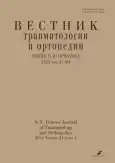Endoprosthetics of the head of the talus for deforming arthrosis of the talonavicular joint
- Authors: Skrebtsov V.V.1, Protsko V.G.1,2, Skrebtsov A.V.1, Tamoev S.K.1, Nikitina V.K.1, Kuznetsov V.V.1
-
Affiliations:
- Yudin City Clinical Hospital
- Russian Peoples’ Friendship University
- Issue: Vol 31, No 4 (2024)
- Pages: 665-675
- Section: Clinical case reports
- URL: https://bakhtiniada.ru/0869-8678/article/view/310546
- DOI: https://doi.org/10.17816/vto625762
- ID: 310546
Cite item
Full Text
Abstract
INTRODUCTION: Idiopathic osteoarthritis of the rearfoot joints most commonly affects the talonavicular joint. Currently, talonavicular osteoarthritis is commonly treated using double and triple arthrodesis, as well as isolated talonavicular arthrodesis. However, restricting functionally significant joints of the foot results in increased load on adjacent joints, causing degenerative changes.
CLINICAL CASE DESCRIPTION: The paper presents a clinical case of surgical treatment in a patient with avascular necrosis of the talar head, deforming arthrosis, and fibrous ankylosis of the talonavicular joint by talar head replacement with an original ceramic implant. The presented case is the first to describe a novel treatment method for gross talonavicular joint pathology using a ceramic implant to replace the talar head.
CONCLUSION: Based on the medium-term outcomes of surgical treatment in a patient with stage III deforming arthrosis and fibrous ankylosis of the talonavicular joint, talar head replacement is a promising treatment option for this condition. The initial findings showed that the proposed implant and its placement method can be used as an option of choice to preserve the mobility of the talonavicular joint.
Full Text
##article.viewOnOriginalSite##About the authors
Vladimir V. Skrebtsov
Yudin City Clinical Hospital
Author for correspondence.
Email: Skrebtsov@mail.ru
ORCID iD: 0000-0003-0833-6628
SPIN-code: 6002-7102
MD, Cand. Sci. (Medicine)
Russian Federation, 4 Kolomenskiy passage, 115446 MoscowViktor G. Protsko
Yudin City Clinical Hospital; Russian Peoples’ Friendship University
Email: 89035586679@mail.ru
ORCID iD: 0000-0002-5077-2186
SPIN-code: 4628-7919
MD, Dr. Sci. (Medicine), professor
Russian Federation, 4 Kolomenskiy passage, 115446 Moscow; MoscowAlexander V. Skrebtsov
Yudin City Clinical Hospital
Email: Skrebtsovalex@mail.ru
ORCID iD: 0000-0002-1418-3368
SPIN-code: 3682-4569
MD
Russian Federation, 4 Kolomenskiy passage, 115446 MoscowSargon K. Tamoev
Yudin City Clinical Hospital
Email: Sargonik@mail.ru
ORCID iD: 0000-0001-8748-0059
SPIN-code: 2986-1390
MD, Cand. Sci. (Medicine)
Russian Federation, 4 Kolomenskiy passage, 115446 MoscowVictoria K. Nikitina
Yudin City Clinical Hospital
Email: vcnikitina@gmail.com
ORCID iD: 0000-0002-0064-3175
SPIN-code: 9868-0332
MD
Russian Federation, 4 Kolomenskiy passage, 115446 MoscowVasilii V. Kuznetsov
Yudin City Clinical Hospital
Email: vkuznecovniito@gmail.com
ORCID iD: 0000-0001-6287-8132
SPIN-code: 6499-2760
MD, Cand. Sci. (Medicine)
Russian Federation, 4 Kolomenskiy passage, 115446 MoscowReferences
- Fogel GR, Katoh Y, Rand JA, Chao EYS. Talonavicular Arthrodesis for Isolated Arthrosis 9.5-Year Results and Gait Analysis. Foot Ankle Int. 1982;3(2):105–113. doi: 10.1177/107110078200300210
- Astion DJ, Deland JT, Otis JC, Kenneally S. Motion of the Hindfoot after Simulated Arthrodesis. JBJS. 1997;79(2):241–6. doi: 10.2106/00004623-199702000-00012
- Savory KM, Wülker N, Stukenborg C, Alfke D. Biomechanics of the hindfoot joints in response to degenerative hindfoot arthrodeses. Clinical Biomechanics. 1998;13(1):62–70. doi: 10.1016/S0268-0033(97)00016-8
- Golightly YM, Gates LS. Foot Osteoarthritis: Addressing an Overlooked Global Public Health Problem. Arthritis Care Res (Hoboken). 2021;73(6):767–769. doi: 10.1002/acr.24181
- Menz HB, Munteanu SE, Landorf KB, Zammit GV, Cicuttini FM. Radiographic evaluation of foot osteoarthritis: sensitivity of radiographic variables and relationship to symptoms. Osteoarthritis Cartilage. 2009;17(3):298–303. doi: 10.1016/j.joca.2008.07.011
- Kalichman L, Hernández-Molina G. Midfoot and forefoot osteoarthritis. The Foot. 2014;24(3):128–134. doi: 10.1016/j.foot.2014.05.002
- Kim DH, Berkowitz MJ. Allograft Dermal Matrix Interpositional Arthroplasty in the Treatment of Failed Revision Arthrodesis at the Talonavicular Joint. Foot Ankle Int. 2014;35(6):619–622. doi: 10.1177/1071100714528497
- Zhang K, Chen Y, Qiang M, Hao Y. Effects of five hindfoot arthrodeses on foot and ankle motion: Measurements in cadaver specimens. Sci Rep. 2016;6(1):35493. doi: 10.1038/srep35493
- Patent RUS № 2801233 С2/ 30.01.23. Byul. №4. Karlov AV, Skrebtsov VV, Protsko VG. Endoprosthesis of the head of the talus bone and the method of its implantation. Available from: https://yandex.ru/patents/doc/RU2801233C2_20230803?ysclid=m2x4sz9a40659836660 (In Russ.). EDN: QKADIX
- Arno F, Roman F, Martin W, Jennifer G, Monika H. Facilitating the interpretation of pedobarography: The relative midfoot index as marker for pathologic gait in ankle osteoarthritic and contralateral feet. J Foot Ankle Res. 2016;9(1). doi: 10.1186/s13047-016-0177-y
- MacConaill MA. The postural mechanism of the human foot. Proc R Ir Acad. 1944–45;50B:265–78.
- Nester CJ, Liu AM, Ward E, et al. In vitro study of foot kinematics using a dynamic walking cadaver model. J Biomech. 2007;40(9):1927–1937. doi: 10.1016/j.jbiomech.2006.09.008
- Polyevktov IA. Human foot in norm and pathology. Dzaujikau: State Publishing House of Sev.-Oset. ASSR; 1949. 112 p. (In Russ.).
- Conti MS, Ellis SJ. Spare the Talonavicular Joint! The Role of Isolated Subtalar Joint Fusion in the Treatment of Progressive Collapsing Foot Deformity. Foot Ankle Clin. 2021;26(3):591–607. doi: 10.1016/j.fcl.2021.05.005
- Roddy E, Thomas MJ, Marshall M, et al. The population prevalence of symptomatic radiographic foot osteoarthritis in community-dwelling older adults: cross-sectional findings from the Clinical Assessment Study of the Foot. Ann Rheum Dis. 2015;74(1):156–163. doi: 10.1136/annrheumdis-2013-203804
- Roddy E, Menz HB. Foot osteoarthritis: latest evidence and developments. Ther Adv Musculoskelet Dis. 2018;10(4):91–103. doi: 10.1177/1759720X17753337
- Weinheimer D. Talonavicular arthrodesis. Clin Podiatr Med Surg. 2004;21(2):227–240. doi: 10.1016/j.cpm.2004.01.003
- Crevoisier X. The Isolated Talonavicular Arthrodesis. Foot Ankle Clin. 2011;16(1):49–59. doi: 10.1016/j.fcl.2010.11.002
- Zhang K, Chen Y, Qiang M, Hao Y. Effects of five hindfoot arthrodeses on foot and ankle motion: Measurements in cadaver specimens. Sci Rep. 2016;6(1):35493. doi: 10.1038/srep35493
- Wülker N, Stukenborg C, Savory KM, Alfke D. Hindfoot Motion after Isolated and Combined Arthrodeses: Measurements in Anatomic Specimens. Foot Ankle Int. 2000;21(11):921–927. doi: 10.1177/107110070002101106
- Jia X, Qiang M, Chen Y, Zhang K, Chen S. The influence of selective arthrodesis on three-dimensional range of motion of hindfoot joint: A cadaveric study. Clinical Biomechanics. 2019;69:9–15. doi: 10.1016/j.clinbiomech.2019.06.011
- Fortin PT. Posterior tibial tendon insufficiency: Isolated fusion of the talonavicular joint. Foot Ankle Clin. 2001;6(1):137–151. doi: 10.1016/S1083-7515(03)00087-1
- Patel A, Eleftheriou KI, Anand A, Rosenfeld P. Bilateral Excision Arthroplasty and Interpositional Allograft for Severe Talonavicular Osteoarthritis. Foot Ankle Int. 2013;34(9):1294–1298. doi: 10.1177/1071100713484006
Supplementary files




















